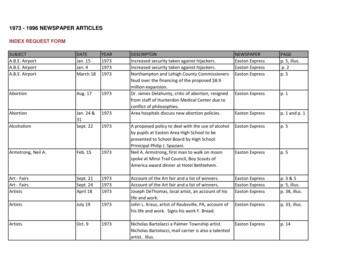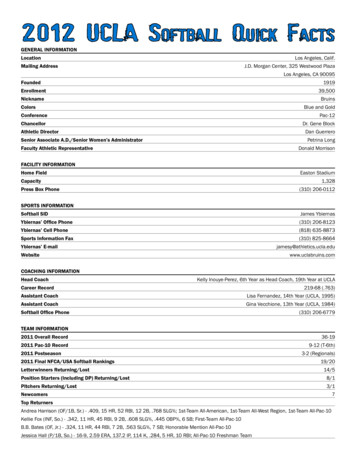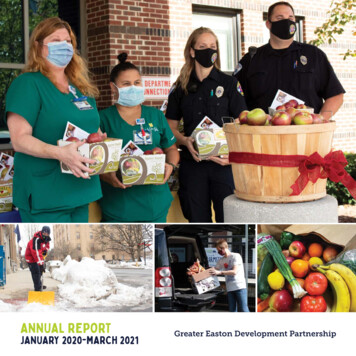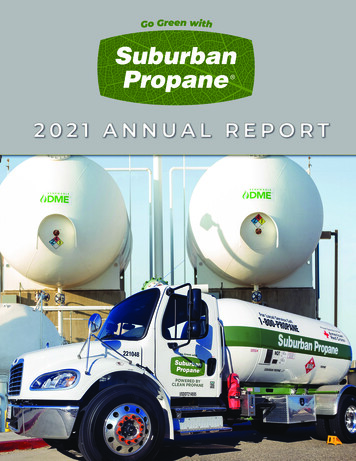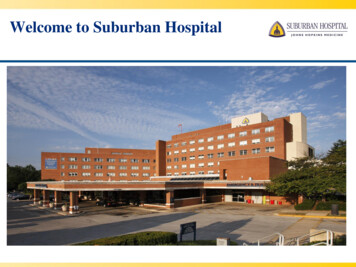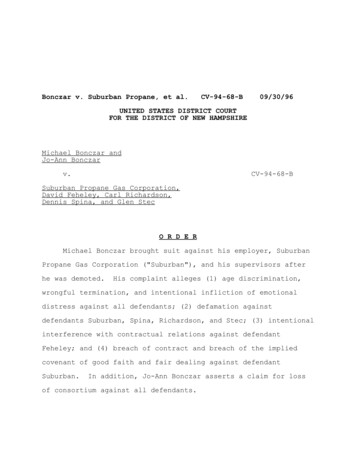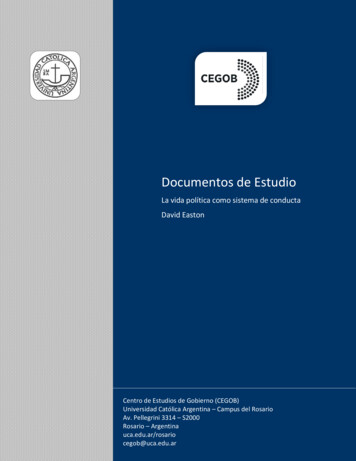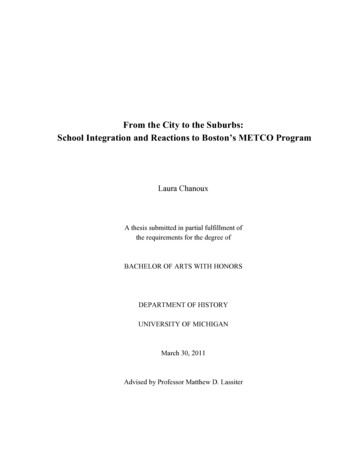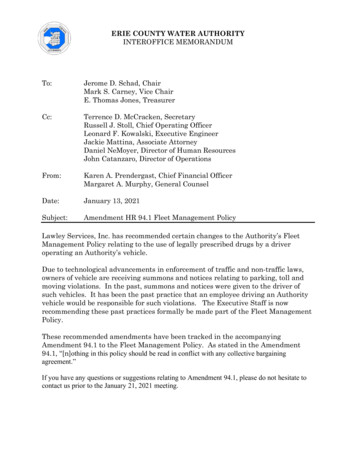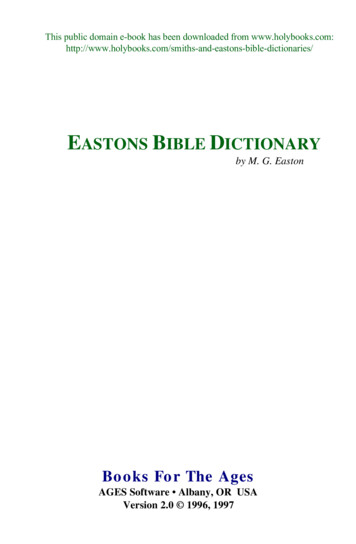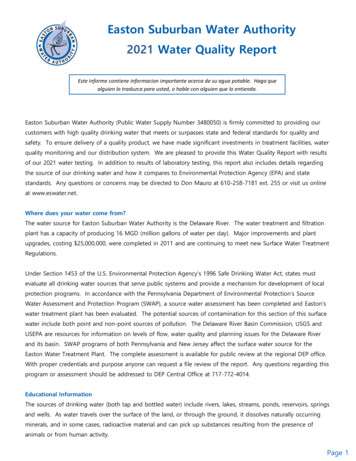
Transcription
Easton Suburban Water Authority2021 Water Quality ReportEste informe contiene informacion importante acerca de su agua potable. Haga quealguien lo traduzca para usted, o hable con alguien que lo entienda.Easton Suburban Water Authority (Public Water Supply Number 3480050) is firmly committed to providing ourcustomers with high quality drinking water that meets or surpasses state and federal standards for quality andsafety. To ensure delivery of a quality product, we have made significant investments in treatment facilities, waterquality monitoring and our distribution system. We are pleased to provide this Water Quality Report with resultsof our 2021 water testing. In addition to results of laboratory testing, this report also includes details regardingthe source of our drinking water and how it compares to Environmental Protection Agency (EPA) and statestandards. Any questions or concerns may be directed to Don Mauro at 610-258-7181 ext. 255 or visit us onlineat www.eswater.net.Where does your water come from?The water source for Easton Suburban Water Authority is the Delaware River. The water treatment and filtrationplant has a capacity of producing 16 MGD (million gallons of water per day). Major improvements and plantupgrades, costing 25,000,000, were completed in 2011 and are continuing to meet new Surface Water TreatmentRegulations.Under Section 1453 of the U.S. Environmental Protection Agency’s 1996 Safe Drinking Water Act, states mustevaluate all drinking water sources that serve public systems and provide a mechanism for development of localprotection programs. In accordance with the Pennsylvania Department of Environmental Protection’s SourceWater Assessment and Protection Program (SWAP), a source water assessment has been completed and Easton’swater treatment plant has been evaluated. The potential sources of contamination for this section of this surfacewater include both point and non-point sources of pollution. The Delaware River Basin Commission, USGS andUSEPA are resources for information on levels of flow, water quality and planning issues for the Delaware Riverand its basin. SWAP programs of both Pennsylvania and New Jersey affect the surface water source for theEaston Water Treatment Plant. The complete assessment is available for public review at the regional DEP office.With proper credentials and purpose anyone can request a file review of the report. Any questions regarding thisprogram or assessment should be addressed to DEP Central Office at 717-772-4014.Educational InformationThe sources of drinking water (both tap and bottled water) include rivers, lakes, streams, ponds, reservoirs, springsand wells. As water travels over the surface of the land, or through the ground, it dissolves naturally occurringminerals, and in some cases, radioactive material and can pick up substances resulting from the presence ofanimals or from human activity.Page 1
Contaminants that may be present in source water include: Microbial contaminants, such as viruses and bacteria, which may come from sewage treatment plants, septicsystems, agricultural livestock operations and wildlife. Inorganic contaminants, such as salts and metals, which can be naturally occurring or result from urban stormwater runoff, industrial or domestic wastewater discharges, oil and gas production, mining or farming. Pesticides and herbicides, which may come from a variety of sources such as agriculture, urban storm waterrunoff and residential uses. Organic chemical contaminants, including synthetic and volatile organic chemicals, which are by-products ofindustrial processes and petroleum production, and also can come from gas stations, urban storm waterrunoff and septic systems. Radioactive contaminants, which can be naturally occurring or a result of oil and gas production and miningactivities.In order to ensure that tap water is safe to drink, EPA prescribes regulations which limit the amount of certaincontaminants in water provided by public water systems. We treat your water according to EPA’s regulations.Food and Drug Administration (FDA) regulations establish limits for contaminants in bottled water which mustprovide the same protection for public health.Drinking water, including bottled water, may reasonably be expected to contain at least small amounts of somecontaminants. The presence of contaminants does not necessarily indicate that water poses a health risk. Moreinformation about contaminants and potential health effects can be obtained by calling the EPA’s Safe Drinking WaterHotline at 800-426-4791.Customer ParticipationResidents can help ensure the safety of our water supply by reporting any suspicious activity near any water tank,reservoir or fire hydrant, to our office at 610-258-7181, 24 hours any day of the week.The Board of Directors of Easton Suburban Water Authority meets on the second Monday of each month at 3:00 pm atthe Authority office located at 3700 Hartley Avenue in Palmer Township. Please feel free to attend and participate inthese meetings.Water Conservation TipsDid you know that the average U.S. household uses approximately 400 gallons of water per day or 100 gallonsper person per day? Luckily, there are many low-cost and no-cost ways to conserve water. Small changes canmake a big difference – try one today and soon it will become second nature. Take short showers – a 5 minute shower uses 4 to 5 gallons of water compared to up to 50 gallons for a bath. Shut off water while brushing your teeth, washing your hair and shaving and save up to 500 gallons a month. Use a water-efficient showerhead. They’re inexpensive, easy to install, and can save you up to 750 gallons a month. Fix leaky toilets and faucets. Faucet washers are inexpensive and take only a few minutes to replace. To checkyour toilet for a leak, place a few drops of food coloring in the tank and wait. If it seeps into the toilet bowlPage 2
without flushing, you have a leak. Fixing it or replacing it with a new, more efficient model can save up to1,000 gallons a month. Adjust sprinklers so only your lawn is watered. Apply water only as fast as the soil can absorb it and duringthe cooler parts of the day to reduce evaporation. Teach your kids about water conservation to ensure a future generation that uses water wisely. Make it afamily effort to reduce next month’s water bill! Visit www.epa.gov/watersense for more information.Special WarningSome people may be more vulnerable to contaminants in drinking water than the general population. Immunocompromised persons such as persons with cancer undergoing chemotherapy, persons who have undergoneorgan transplants, people with HIV/AIDS or other immune system disorders, some elderly and infants can beparticularly at risk from infections. These people should seek advice about drinking water from their health careproviders. EPA/CDC guidelines on appropriate means to lessen the risk of infection by Cryptosporidium andother microbial contaminants are available from the Safe Drinking Water Hotline at 800-426-4791.Cryptosporidium TestingCryptosporidium is a microbial organism found in rivers and streams throughout the United States. EastonSuburban Water Authority began testing in August 2016 to monitor for Cryptosporidium and concludedmonitoring in July 2018. One sample per month was collected from the Delaware River. Current test methods donot allow us to determine if the organisms are dead or if they are capable of causing disease. Our treatmentprocesses include, disinfection to inactivate organisms and filtration that will remove Cryptosporidium, but thisdoes not guarantee that 100% of the organisms will be removed.Cryptosporidium must be ingested to cause illness, and it may be spread by means other than drinking water.Ingestion of Cryptosporidium may cause an abdominal infection with symptoms including nausea, diarrhea andabdominal cramps. Most healthy individuals can overcome the illness within a few weeks. However, immunocompromised people are at greater risk of developing life-threatening illness. We encourage immunocompromised individuals to consult their doctor regarding appropriate precautions to take to avoid infection.Unregulated Contaminants Rule (UCMR)The 1996 Safe Drinking Water Act (SDWA) amendments require that once every 5 years EPA issue a new list of 30unregulated contaminants to be monitored by public water systems. Unregulated contaminants are those forwhich the EPA has not established drinking water standards. The purpose of unregulated contaminantsmonitoring is to assist the EPA in determining the occurrence of unregulated contaminants in drinking water andwhether future regulation is warranted.UCMR lists 1, 2 and 3 were monitored and completed in compliancewith EPA requirements. Monitoring of UCMR list 4 had begun 2018 and was concluded in November 2020.Page 3
Water Quality DataThe tables on the following pages list all of the drinking water contaminants that we detected during the 2021calendar year. The presence of contaminants in the water does not necessarily indicate that the water poses ahealth risk. Unless otherwise noted, the data presented is from testing done January 1 – December 31, 2021.The state requires us to monitor for certain contaminants less than once per year because the concentrations ofthese contaminants do not change frequently.MCLGContaminantRangeorMCL, TT,YourSampleMRDLor ical SourceGDistribution Chemical ContaminantsChlorine (ppm)Haloacetic Acids(HAA5) 021NoTotalTrihalomethanes(TTHMs) (ppb)Microbiological ContaminantsNoWater additive used to controlmicrobesBy-product of drinking waterchlorinationBy-product of drinking waterdisinfectionRangePresence ofColiform inTotal Coliform0 5% of 1%MonthlyNaturally present in theenvironmentSamplesEntry PointNoRangeFluoride (ppm)220.602021NoWater additive whichpromotes strong teethBarium (ppm)220.022021NoErosion of natural deposits00.005 .00052021No2020NoErosion of natural deposits2020NoErosion of natural depositsMethyleneChloride (ppm)(Dichloromethane)Radiological ContaminantsRadium 226(pCi/L)Radium 228(pCi/L)NoOrganic chemicals that have ahigh vapor pressureRange0.32205 /0.2970.98305 /0.376Page 4
ContaminantMCLGMCLLevelSampleDetectedDateTT 1 NTU for a singleTurbidity (NTU)0.14measurement 0.15ViolationNo2021TT at least 95% ofmonthly samples 0.3Typical SourceSoil runoff100%NoNTUContaminantremovalRequiredTotal OrganicNo. of quarters out ofcompliance?achieved35CarbonContaminantRange of% l ypical SourceNaturally present in theenvironmentTypical SourceEntry Point Disinfectant ResidualChlorine ileUnitsValueNo# SitesExceedsabove ALAL?Water additive used to controlmicrobesTypical SourceLead and CopperCorrosion of householdLead (ppb)150 0.001ppb0 out of 30Noplumbing systems; erosion ofnatural depositsCorrosion of householdCopper (ppm)1.31.30.089ppm0 out of 30Noplumbing systems; erosion ofnatural depositsCorrosion ControlAdditiveRecommended RangeYour WaterSample SourceOrthophosphate0.7 PPM or greater1.33 ppmDistributionOrthophosphate0.8 PPM or greater1.38 ppmEntry PointAdditional Information for LeadIf present, elevated levels of lead can cause serious health problems, especially for pregnant women andyoung children. Lead in drinking water is primarily from materials and components associated with servicelines and home plumbing. Easton Suburban Water Authority is responsible for providing high quality drinkingwater but cannot control the variety of materials used in plumbing components. When your water has beensitting for several hours, you can minimize the potential for lead exposure by flushing your tap for 30 secondsto 2 minutes before using water for drinking or cooking. If you are concerned about lead in your water, youmay wish to have your water tested. Information on lead in drinking water, testing methods and steps youcan take to minimize exposure is available from the Safe Drinking Water Hotline at 800-426-4791or atwww.epa.gov/safewater/lead.Page 5
Additional MonitoringContaminantsRecommended Limitsor RangeYour WaterTypical SourceTotal Alkalinity0-60 ppm30.9 ppmAluminum0.2 ppm 0.010 ppmCalcium HardnessNone28.2 ppmSecondary DrinkingChloride250 ppm18.2 ppmWater Standards refer toColor15 Color Units 5 Color Unitsrecommended limits onSilver0.1 ppmFoaming Agents (MBAS)0.5 ppm 0.05 ppmpose a nuisance to theTotal HardnessNone44.0 ppmcustomer.Iron0.3 ppm 0.100 ppmThese compounds affectManganese0.050 ppm 0.010 ppmaesthetic qualityOdor3 TON1 TON(appearance, taste andpH6.0 to 8.57.3odor) but do not pose aSulfate250 ppm20.9 ppmhealth risk.Total Dissolved Solids500 ppm115 ppmZinc5 ppm0.285 ppmCalciumNone 0.001 ppmcompounds that might11.3 ppmPage 6
Terms and AbbreviationsALMCLMCLGNTUAction LevelMaximum ContaminantLevelThe concentration of a contaminant which, if exceeded, triggers treatment orother requirements that a water system must follow.The highest level of a contaminant that is allowed in drinking water. MCLsare set as close to the MCLGs as feasible using the best available treatmenttechnology.Maximum ContaminantThe level of a contaminant in drinking water below which there is no knownLevel Goalor expected risk to health. MCLGs allow for a margin of safety.Nephelometric TurbidityUnitsA measure of water clarity.pCi/LPicocuries per literA measure of radioactivity.TONThreshold Odor NumberA measure of odor.Parts per million orppmmilligrams per literOne part per million equals about: 1 minute in 2 years or 1 inch in 16 miles.(mg/L)Parts per billion orppbmicrograms per liter(μg/L)TTTreatment TechniqueNANot ApplicableMRDLMRDLGMaximum ResidualDisinfectant LevelMaximum ResidualDisinfectant Level GoalOne part per billion equals about: 1 second in 32 years or 1 inch in 16,000miles.A required process intended to reduce the level of a contaminant in drinkingwater.Results are not applicable.Highest level of disinfectant allowed in drinking water. There is convincingevidence that additional disinfectant is necessary for control of microbialcontaminants.The level of a drinking water disinfectant below which there is no known orexpected risk to health. MRDLGs do not reflect the benefits of the use ofdisinfectants to control microbial contamination.Violations:None.Page 7
The water source for Easton Suburban Water Authority is the Delaware River. The water treatment and filtration plant has a capacity of producing 16 MGD (million gallons of water per day). Major improvements and plant upgrades, costing 25,000,000, were completed in 2011 and are continuing to meet new Surface Water Treatment Regulations.
